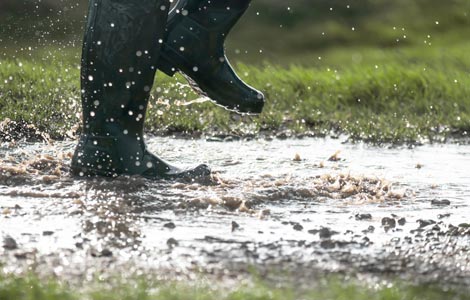Investing in a good, reliable pair of wellies can make all the difference to your day. To help you to get the most out of your boots, here are some care tips to keep them in top shape for years to come.
Keep it clean
Wellies are absolutely designed for getting deep into the muck, but fight the temptation to just kick your muddy boots off when you get home.
Dirt, mud & muck on left to dry on the boot will pull the moisture out of the rubber of your boots. This will prematurely age them, increasing the likelihood of cracks or splits.
A quick wipe down or, better yet, a good spray from a hose to clean off any build-up when you get home will go a long way to keeping the rubber from drying out.
A molecular matter
Rubber reacts with oxygen in the air over time. This oxidation process changes the rubber at its molecular level, becoming more brittle as the bonds break down.
Just like rust forming on metals, a wet environment will speed this up dramatically. After a quick spray down to clear off the dirt, give your boots a light towelling down before letting them dry naturally.
Don’t be tempted to put them by the fire, next to a radiator or in direct sunlight – while extreme heat can obviously do physical damage to your boots, prolonged heat will also pull moisture out of the rubber and aids the oxidation process.
If you do find yourself desperate to dry out wet boots quickly, a boot dryer is a great option to gently dry the inside of the boot without causing undue stress to the rubber outer.
Consider where you store your boots too – a garden shed or outbuilding might seem a convenient spot to keep your wellies, but damp air will increase the rate of oxidation. UV-A radiation from the sun can pass through glass, so a bright porch or conservatory can also age the rubber more quickly. If possible, a cool, dark & moderately dry cupboard is the ideal place to keep your wellies.
Watch your step
Some common substances can be particularly damaging to rubber (and, indeed, leather). Here are a few common ones to watch for that you might encounter:
- Manure (and particularly cow poo) is acidic and will eat away at your boots over time
- Salt from sea water, gritted roads/pavements and so on will pull the moisture out of the rubber very quickly
- Industrial chemicals – watch out for paints, fertilisers, cleaning solvents, oils & other potentially corrosive substances*
While this list shouldn’t keep you from getting your job done, be mindful of anything that might be damaging to your boots and give them some extra TLC after exposure.
*Some welly boots are treated to make them more resilient to common agricultural/manufacturing chemicals. See our selection of work & farming wellies for some examples.
Give them some love
Topping up the moisture in your boots is very simple – some natural oils can be used to do this, or there are a host of specialised rubber care sprays available. As well as restoring the moisture in your boots, some of these can also provide some extra UV protection and help to repel mud & dirt.
A great product for wellies is Grubs Revivex Rubber Care 120ml – £9.95
How often you do this will depend on how hard you are on your wellies, but twice a year is a good guide for the average user. If your boots are regularly exposed to common hazards, or if you live in them day in & day out, a more regular regime will help keep your trusty welly boots in top condition.

